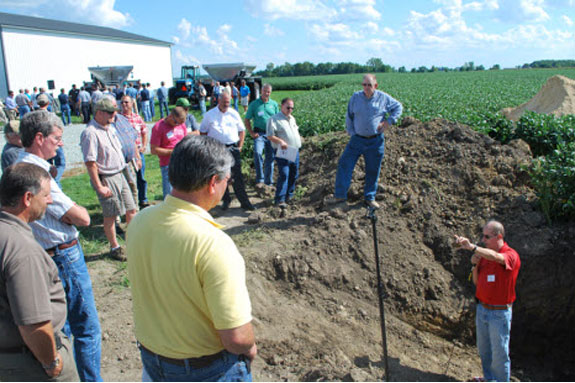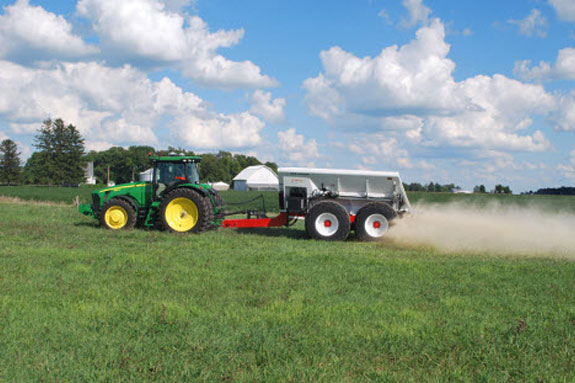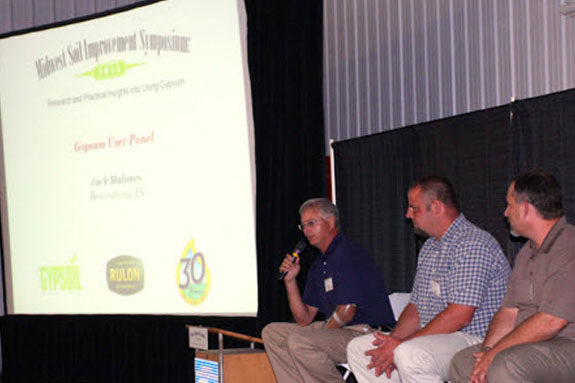The agronomist had seen tight clay soils like Maloney’s become softer and more permeable to rain water after two or three applications of gypsum.
"Now we can take a 2-inch rain and not pond,” said Maloney.
"The water infiltration is phenomenal. And it helps structure the soil.”
The Midwest Soil Improvement Symposium: Research and Practical Insights into Using Gypsum was held Aug. 21 at Rulon Enterprises, a family farm operation in Arcadia, Indiana. The Rulon operation is managed by Ken, Rodney and Roy Rulon, and Roy’s sons Nick and Neal.

In addition to Rulon Enterprises, the Conservation Technology Information Center and the GYPSOIL Division of Beneficial Reuse Management sponsored the symposium.
Symposium host Rodney Rulon says gypsum helps “supercharge” his family’s no-till cropping system.
The Rulons began applying gypsum seven years ago to problem fields where persistent wet spots delayed fieldwork and reduced yield.
After seeing changes in the soil’s physical properties resulting in quicker drying and better crop results, applications of 1 to 1.5 tons gypsum per acre became a staple across their entire 5,900-acre system.
"We’re using it to build soil structure and healthy no-till soils,” explained Rulon.
At the one-day symposium, university and USDA researchers, industry experts, crop consultants and experienced growers presented sessions on the impact of using gypsum on crop production, soil and water quality, water infiltration, erosion, runoff and nutrient loss.
Field demonstrations of gypsum application equipment and soil physical properties were also part of the program. Approximately 150 researchers, crop consultants and growers attended.
Banking moisture
Maloney, who operates a 2,600-acre no-till farm based in Brownsburg, Indiana, has observed dramatic differences between his fields and neighboring conventional fields during wet years, as well as dry years such as 2008 and this past season.
“Our crop stays green where the others are fired up,” he said.
USDA research indicates that gypsum helps soil absorb more water and hold onto it for use later in the growing season.
That improves crop yield, especially in no-tilled fields, according to Allen Torbert, lead researcher at the USDA’s National Soil Dynamics Laboratory in Auburn, Alabama, where several gypsum trials are underway.
“Gypsum improves soil physical properties. It improves aggregation, increases water infiltration, reduces runoff, improves water-holding capacity, and reduces erosion losses and nutrient losses,” Torbert said.
Better aggregation
Gypsum contains soluble calcium, which counteracts sodium and magnesium, and helps improve soil particle aggregation, according to Jerry Bigham, professor emeritus, School of Environment and Natural Resources, The Ohio State University.
Clay-type soils in the Midwest often have high concentrations of magnesium, particularly soils historically treated with high-magnesium limestone, he said.
Without remediation with calcium, clay soil particles act like a “house of cards,” Bigham explained. “There is a natural tendency for those particles to fly apart or disperse.”
When dispersion occurs, soils are prone to compaction and crusting, which contributes to faltering plant emergence and poor rooting.
By contrast, strong, well-aggregated soil particles, surrounded by defined pores, are what make up ideal soil structure.
“We need large pores that can receive and transmit water during times of excess, and we need small pores that can hold water by capillary action during times when we have (moisture) stress,” Bigham said.
Improved soil quality enhances soil biology, emphasized Maloney in his remarks. “It makes that ground sweeter,” he said. “We have a ton of earthworms out there working for us.”
Gypsum also contributes to optimal root growth.
“We can get 10 times more surface area of the root by adding a soluble calcium source. This can make a difference to carry the crop over until the next rainfall event,” said Darrell Norton, a soil scientist recently retired from the USDA Agricultural Research Service’s National Soil Erosion Laboratory in West Lafayette, Indiana.
FGD gypsum
Gypsum, or calcium sulfate dihydrate, has been used for centuries. The cost of mining and shipping gypsum to crop producers, however, caused agricultural use of gypsum to dwindle over time except for on high value crops like potatoes, tomatoes and peanuts.
But thanks to the 1990 Clean Air Amendments, there is a new supply of high quality and lower cost synthetic gypsum available called flue gas desulfurization gypsum or FGD gypsum. FGD gypsum is produced as a byproduct by wet scrubbing systems used to clean emissions at certain coal-fired utilities.
FGD gypsum contains 20 percent soluble calcium or about 400 lbs/ton and 16 percent sulfate sulfur or about 320 lbs/ton, explained Ron Chamberlain, agronomist and director of gypsum programs for GYPSOIL/Beneficial Reuse Management.
It has the same basic chemical composition as mined gypsum but at significantly lower cost.
FGD supplies are becoming more widely available as more scrubbers come online, noted Chamberlain.
Sulfur depletion
University of Illinois soil fertility and plant nutrition specialist Fabian Fernandez outlined his work studying sulfur response in corn.
He said sulfur deficiency has increased across the Midwest in recent years because less sulfur is being deposited from the atmosphere as a result of emissions regulations. In addition, high producing crops have greater removal rates, Fernandez said.
Fernandez has seen a response to added sulfur in some, but not all, Illinois trials.
Warren Dick, a professor in the School of Environment and Natural Resources at The Ohio State University, presented several research reports that showed significant yield responses in alfalfa and corn when gypsum was used as a sulfur source.
“Gypsum puts an abundance of sulfur out there,” Rulon commented. “Deficiencies kind of become a non-issue.”
Click here to download symposium presentations. FG
—From Midwest Soil Improvement Symposium news release
PHOTOS
TOP: Jack Maloney (left), a corn and soybean grower from Brownsburg, Indiana, discusses how he uses gypsum as part of his no-till system to improve water infiltration and soften tight clay soils. Sitting next to him are fellow panelists Cameron Mills (middle), Walton, Indiana; and Rodney Rulon (right) who is a partner in Rulon Enterprises where the symposium was held.
MIDDLE: L. Darrell Norton, a retired soil scientist from the National Soil Erosion Research Lab, USDA – Agricultural Research Service, explains soil profile changes resulting from gypsum applications.
BOTTOM: Nick Rulon of Rulon Enterprises demonstrates gypsum application. Photos courtesy of Midwest Soil Improvement Symposium.










